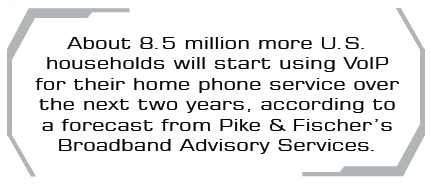Least Cost Routing and SaaS: The LNP Linchpin
By Steve Smith
In 2003, the FCC mandated that wireless and wireline carriers provide local number portability, thereby allowing subscribers to retain their existing mobile or landline number when changing service providers. The result is that carrier networking professionals are challenged to route highly complex voice and data VoIP/TDM traffic over next-generation networks.
About 8.5 million more U.S. households will start using VoIP for their home phone service over the next two years, according to a forecast from Pike & Fischer's Broadband Advisory Services. The number of VoIP-connected households in the United States will approach
30 million by the end of the decade, generating more than $11 billion in revenue for cable operators, telephone companies and network-independent providers such as Skype, P&F predicts.
A carrier's bottom line is directly and significantly affected by how quickly and accurately carriers are able to analyze, select and route this voice traffic.
That's where least cost routing comes in, particularly in a SaaS business model. LCR is the process of determining where a call originates and then selecting the path of outbound communications traffic based on the least cost. The quality of a call is another factor that must be taken into account.
Routing is resource (both human and hardware) intensive; when factoring in the additional step of local number portability, the complexity rises exponentially.
Price and dial code changes must be identified, verified and acted upon quickly and accurately
to obtain the most favorable rates when configuring complex routing structures. With the number of dial codes that are porting at any one time skyrocketing, how do you know your billing is accurate?
All of the major carriers rate off of local routing numbers, and the smaller carriers are in the process of moving to LRN rating as economical solutions
are provided to them. This means that larger carriers already have built in the protection on the front end to avoid hidden charges. Smaller carriers don't know what happened until after it's already happened.
Without solid LNP processes or systems in place, carriers may be forced to watch their profit margins shrink.

For a carrier's LCR team, automating the LCR is the way to go. Manual processes cost time and money and leave the carrier open to data integrity errors, which can be costly. Today's LCR software is designed to find the most profitable route for every call, at every junction in the routing map; handle nearly unlimited codes, routes and bindings; upload and change routing on the fly; as well as blend TDM and IP network with centralized routing.
In addition to increased accuracy and time savings, by deploying an automated solution, a carrier typically can reduce by one or two the full time equivalent staff, rate managers, analysts, support staff, necessary for manual route monitoring. These staffers can be redeployed
to work on things that make the carrier more competitive.
If carriers are already heavily invested in legacy equipment or face capex or opex obstacles to purchasing new equipment, they may face internal opposition to purchasing yet another box.
For some time, the benefits of the software as a service business model have been well recognized by enterprises, and more and more telecom companies are taking advantage of a SaaS business model for technologies. The concept of LCR via SaaS delivery opens a door that allows carriers to leverage the economics of powerful and extensible LCR tools on a pay-as-you-grow basis. As the routing demands
change or the NGN requirements change, so do the carrier's SaaS tools, allowing instant-on scalability of features and capabilities
without cumbersome and expensive upgrades.
By allowing carriers to try and buy technology
and easily layer it into existing infrastructure
and processes,
the time to market to introduce
new service offerings speeds up dramatically as well. Not only does no up-front investment mean a lower risk, but ease of deployment and affordability
are among the key drivers of SaaS LCR offerings.
With today's increasingly complex traffic across converged networks, a carrier can see profit margins erode. For example, by not routing with LNP, a carrier can realize a 30 percent or greater cost, which they won't see until the end of the month, when it is too late to act on. For a carrier, it literally means profit running out the back door. LCR via SaaS is the linchpin
that gives a carrier the opportunity to deploy technology that will allow the carrier's network to migrate TDM to VoIP traffic across existing network devices, at lower opex, and at healthy profit margins.

Steve Smith is Vice President of Sales and Marketing at SourceComm
(www.sourcecomm.net ).
NGN Magazine Table of Contents







